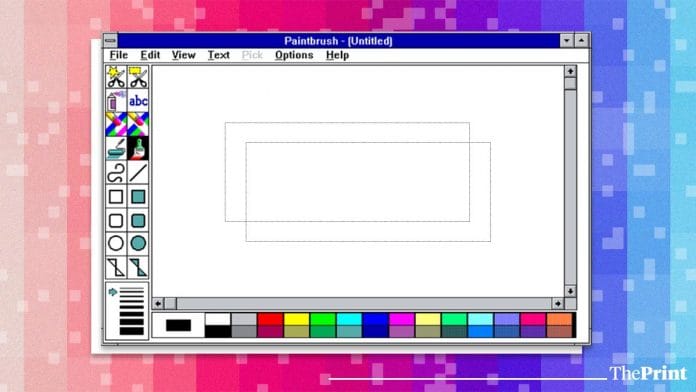Raise your hands if you remember moving your cursor over a dark grey toolbox to the left of the screen of your heavy desktop, and then using a virtual pencil, paintbrush or spray can to magically create art out of splashes and streaks across a digital canvas. All thanks to Microsoft’s paint tool.
The term MS Paint doesn’t actually refer to any one single software but is generic shorthand for “whichever bitmap-based graphics programme is standard with the current Windows operating system,” writes media historian Patrick Davison in Journal of Visual Culture.
The original MS Paint, called Windows Paint, was launched with Windows 1.0 in 1985. But it was updated with the introduction of Windows 3.0 in 1990, and that version, called Microsoft Paintbrush, remained the standard for the next several years.
Even the Windows 95 update didn’t involve significant changes for Paintbrush (barring the name, which was changed to Paint), and the next big change really only came in 2007, with the launch of Windows Vista. This meant that for almost two decades, Microsoft Paintbrush was effectively the last word in paint software in India, especially given other historic changes taking place.
By the mid-90s, economic reforms had been ushered in and households across India had slowly started to acquire basic desktops. Then, before the turn of the millennium, internet, email services and messenger services had also taken root, and Indian children, were, for the first time, truly growing up with computers. And so it was that Microsoft Paintbrush became virtually every urban Indian child’s first digital painting canvas.
Also read: Planet M — brand that changed how Indians experienced music in new millennium
Simplicity was its USP
Davison writes on the changes from the original: “The tool palette moved to the left edge of the screen, and the color palette stretched across the bottom. The ‘brush’ tool remained, the ‘pencil’ disappeared, the ‘paint can’ became a ‘paint roller’. The shape tools fell from 12 to 8, and the bezier curve tool now required two control points (making ‘S’ curves possible). The largest change, however, was that the program now worked with color. Gone were the bitmapped checkerboard patterns of Windows Paint – replaced with hues produced by mixing 256 values each of red, green, and blue.”
For many urban Indians growing up in the ’90s, Microsoft Paintbrush was the go-to for basic cut-copy-paste jobs, adding texts, creating funny doodles, testing their handwriting using a mouse, creating portraits of their favourite superhero. It’s no surprise that this was a canvas upon which memes still used today, like Rage Face and Dolan Duck, were created too.
Kriti Garg, a 24-year-old artist and photographer based in New Delhi, recalls, “I first used MS Paint in second grade in my Computer Science class. The teacher taught us how to launch the software and the first thing I did was colour the entire background black and then turn it into a chessboard with the help of an eraser tool.”
It was just so plainly simply that anyone could use it. It had a graspable interface unlike other graphic programs at the time that used a language of technology that only engineers would understand. It was based on the concept of a bitmap rather than “geometrically defined objects” and later incarnations haven’t really strayed from this basic concept, explains Davison.
“MS Paint has remained comparatively familiar and accessible since its initial incarnation in 1985.” If anything, MS Paint was a little too simple. “If innovation and technical elegance were the only standards of a medium’s historical or cultural merit, there would not be much to say about MS Paint,” adds Davison.
In this way, the rudimentary graphics tool can be viewed as a somewhat democratic platform where one could produce art with no real training. Compare this to advanced photo-editing programmes of today, such as Photoshop, Illustrator or CorelDRAW, which have complex features like layers, filters, QR code generators and customisable interfaces that are used by visual artists and graphic designers rather than the average Joe.
However, that’s not to say that trained artists don’t take the software seriously. Legally blind graphic artist Hal Lasko from Ohio, US, earned the name ‘Pixel Painter’ in the early 2010s for his intricate artworks using MS Paint. He was around 97 years old when his works, described as “a collision of pointillism and 8-Bit art”, gained recognition.
Lasko, who passed away in 2014, had previously worked on weather maps and other guides for military bombing runs in World War II and was also a typographer at one point, but his vision had weakened with age. When his family gifted him a computer in 2000, his grandson helped him navigate the wonders of MS Paint, little did Lasko know it would give Painthim a whole new lease of life in his last 14 years.
Though Microsoft Paintbrush is long gone, there is a web-based version that one can revisit for nostalgia’s sake. And even though Microsoft, in 2017, wanted to do away with the Paint tool altogether, the public outcry ensured they abandoned their plans and moved the tool, in its latest version called Paint 3D, to the Windows Store where it is available for free.
Also read: Boroline — the cure-all that is stuck in time but still brings joy, especially to Bengalis







I loved that program, it was so simple and I’m still using it today, although I’ve switched to Linux ages ago. If you’re a Linux user and want Paint back, you have to look for “KolourPaint”, it’s a copy of MS Paint plus some really neat improvements, but not too much. A perfect balance between simplicity and usefulness.